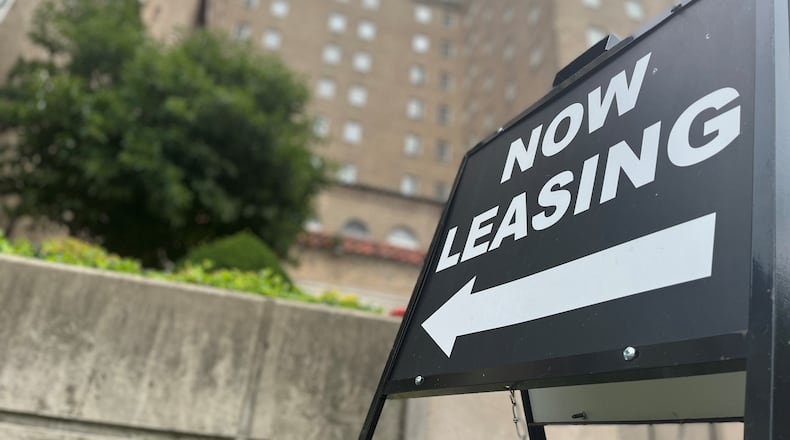“Though rising wages help, the real solution is we need more affordable housing units all across the state of Ohio,” said Amy Riegel, executive director of COHHIO. “We have to start making substantial investments in the development of affordable housing.”
The average fair market rent in the Dayton metro area is about $872 for a modest two-bedroom apartment, according to the 2022 Out of Reach report by COHHIO and the National Low Income Housing Coalition.
Rents in red-hot areas like downtown Dayton are far higher than that.
Full-time workers in the area would need to earn about $16.77 per hour to afford $872 per month, without shouldering a heavy housing cost burden, the report states.
Rent is generally considered affordable if renters do not have to spend more than 30% of their gross income on housing.
But renters in the region on average earn about $16.40 per hour, the report says, and many people make less than that.
More than one-third of households in the Dayton metro area are rentals, or more than 121,500 units. The metro area consists of Montgomery, Miami and Greene counties.
A Dayton Daily News analysis of U.S. Bureau of Labor Statistics data found that some major occupational categories on average pay less than $16.77 per hour in the Dayton region.
This includes jobs and professions in food preparation and serving ($12.69 per hour); personal care and service ($14.80/hour); healthcare support ($15.62/hour); building and grounds cleaning and maintenance ($15.78/hour); and farming, fishing and forestry ($16.33/hour).
Combined, more than 61,000 people in the Dayton region work in those occupations, and food preparation and serving is the second largest local occupation, after office and administrative support jobs.
The third largest local occupational category — sales and related occupations — has about 30,200 local workers.
While its average pay is $20.22 per hour, these occupations’ median hourly wage is $14.12.
Some experts think median wages are a more accurate way to measure compensation levels than average wages, because a small number of high-income earners can skew the numbers.
Median wages mean half of workers earn more than that amount and half earn less. In every occupational category, median wages were less than average wages.
Dayton and the surrounding area need more affordable housing, said Wesley Young, executive vice president of St. Mary Development Corp.
“Most of the existing properties are fully leased with long wait lists,” he said. “Market rate rents downtown are approaching $2,000 per month or more. Most all affordable rents are less than half that.”
A recent market study that St. Mary Development Corp. helped commission says Dayton needs more than 3,800 additional rental units in the next five years to keep up with demand.
The study says nearly half of those units need to be affordable for households earning about $37,850 or less.
The analysis also found that about 43% of renter households in Montgomery County were burdened by housing costs.
Cost-burdened households may have difficulty paying for other necessities, said Riegel.
Without access to affordable housing, some people have to double up or live in substandard units that may have health and safety issues, she said.
Some people and families who are unable to find housing within their budgets end up homeless, she said.
COHHIO, the National Low Income Housing Coalition and more than 200 other organizations and companies are urging the governor and state lawmakers to dedicate about $308 million of its $5.6 billion in federal coronavirus rescue funds toward new affordable housing.
Riegel says state leaders have been receptive to this proposal, but there is tough competition for the funds and groups have many good ideas for how to spend them.
However, Riegel said affordable housing should be a top priority, since housing stability is a cornerstone of good health that plays an important role in meeting other fundamental needs.
Research suggests affordable housing is a cost-effective strategy for reducing childhood poverty, increasing economic mobility and improving the well-being of kids and families, according to the National Low Income Housing Coalition.
Major occupations and what they pay in the Dayton metro area
| Occupation (listed from largest to smallest, based on # of workers) | # of workers | Average hourly wage | Median hourly wage |
|---|---|---|---|
| All occupations | 354,980 | $26.42 | $21.71 |
| Office and administrative support | 42,070 | $19.79 | $18.03 |
| Food preparation and serving related | 30,530 | $12.69 | $10.89 |
| Sales and Related | 30,210 | $20.22 | $14.12 |
| Transportation and material moving | 30,020 | $18.30 | $17.05 |
| Production | 29,750 | $19.81 | $18.09 |
| Healthcare practitioners and technical | 29,140 | $40.18 | $30 |
| Business and financial operations | 24,540 | $38.53 | $37.03 |
| Educational instruction and library | 21,770 | $29.94 | $29.21 |
| Management | 18,140 | $52.59 | $47.62 |
| Healthcare support | 15,770 | $15.62 | $14.20 |
| Computer and mathematical | 13,970 | $40.74 | $37.71 |
| Installation, maintenance and repair | 12,090 | $24.31 | $22.88 |
| Architecture and engineering | 10,170 | $45.24 | $43.59 |
| Building and grounds cleaning and maintenance | 9,850 | $15.78 | $14.34 |
| Construction and extraction | 9,680 | $25.73 | $23.42 |
| Protective service | 7,240 | $25 | $23.08 |
| Community and social service | 5,750 | $24.66 | $23.16 |
| Personal care and service | 4,930 | $14.80 | $13.46 |
| Arts, design, entertainment, sports and media | 4,070 | $26.31 | $22.99 |
| Life, physical and social science | 3,150 | $41.74 | $39.38 |
| Legal | 2,070 | $37.70 | $30.89 |
| Farming, fishing and forestry | 240 | $16.33 | $14.39 |
SOURCE: Occupational Employment and Wage Statistics from the U.S. Bureau of Labor Statistics
About the Author


